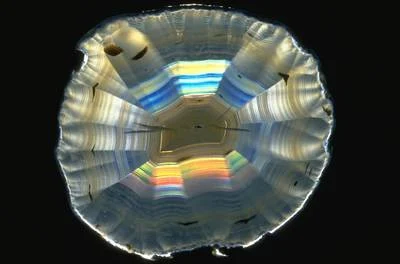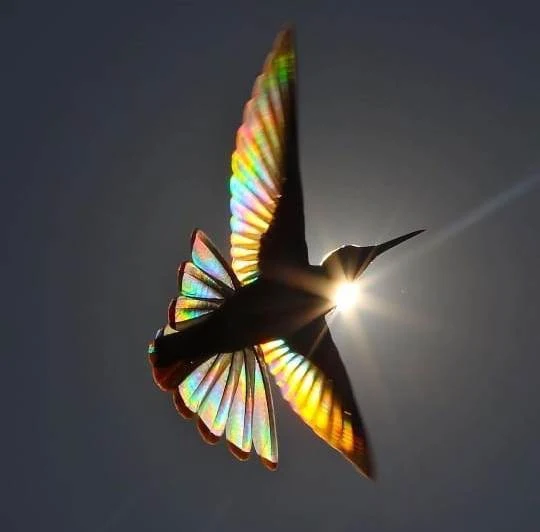 |
| Iris agate |
As shown in Figs. 1 to 5, will be at. right angles to the polished surface. The slice will show the brightest colours if it is thin (1 mm. or less) because the absorbing and scattering effect of any milkiness will then be at a minimum. If the line spacing is uniform, as in Fig. 1, a very thin slice will show primary colours even if the layers in the agate are somewhat inclined to the polished or lacquered surface, although the slice may have to be tilted to correct for the inclination. A specimen which shows primary colours in very thin section may show only pastel colours if it is cut too thick. If the line spacing is not quite uniform only pastel colours may be seen, and if it is very irregular only a chatoyance will be observed.
A single band of uniform spacing will show only one colour for a given position but any adjacent band of uniform but the different spacing will give a different colour for the same position because a fine spacing will diffract anyone wavelength through a larger angle than a coarser grating. In addition, the finer gratings separate the colours from each other more than do the coarser gratings, consequently they give purer, more saturated colours.
Fig. 2. Iris agate between crossed nicols showing single lines and turtleback. 80X.
LINES PER INCH
The fineness of structure observed in iris agates ranges from about fifteen thousand to as few as four hundred lines per inch. Figure 1 shows; a specimen having about 10,000 lines per inch. Part of Fig. 2 shows only 400 lines per inch. Finer and coarser spacings may exist in some agates but any spacing in this range will show the grating effect. A grating of only 100 lines per inch will show diffraction colours but they will be so close to the illuminating beam that they will be difficult to see. Gratings as fine as 30,000 lines per inch have been observed by the author in some crystalline organic materials.
CORRELATION OF GRATING LINES AND CRYSTALS
The lines in iris agate are always at right angles to the length of the needle-like crystals of chalcedony. Figure 1 shows an unusually straight set of lines but even these are slightly wavy because the crystals are not all exactly parallel to each other. It should be pointed out also that the waves run along with the layers within the specimen at right angles to the cut surface, but the amplitude of the waves is small and a thin slice will give good colour in spite of the front to back waviness. Figure 2 shows lines that curve because the crystals have grown in radiating clusters. This structure is sometimes termed "turtleback" or "spherulitic." Figure 3 shows a relatively coarse structure of varying fineness and also reveals that the banding is continuous across adjacent groups of crystals in spite of abrupt changes in direction. Figure 4 is the same specimen as Fig. 1 but seen between crossed nicols and at only 80X. The irregular, ragged black bands indicate changes in polarization colours of the chalcedony but do not correlate with the grating structure. (See Fig. 5.) Such coarse patterns appear to the unaided eye as a woven cloth such as burlap.
Fig. 4. Iris agate between crossed nicols. 80X.
Fig. 5. A. Iris agate between crossed nicols showing start of narrow band where crystal size changes. 80X. B. Start of the grating band seen in A. 200X.
Figure 5A shows a band of iris starting where short, relatively jumbled crystals change to long, nearly parallel crystals. Figure 5B shows the start of the grating band at higher magnification. In most specimens the iris bands show a higher order of polarization colour arid more uniform orientation than adjacent bands which do not show the iris grating structure; however, these differences are not always noticeable. The band of the iris which begins where the crystal size changes (Fig. 5) becomes finer where a band of cloudy material extends across the field but becomes coarser again beyond the cloudy zone. This cloudy material may be opal which can exist between the crystals of chalcedony.6 Colloidally dispersed impurities such as the brown ferric hydroxide type of gelatinous appearing "moss" often occur in the bands between the iris bands, but very little such coloured impurity is ever-present in the iris bands themselves. In any case, it appears that the chalcedony in which the grating structure is present must be quite pure and sufficiently free from porosity to prevent much diffusion of iron stain or dyes between the crystals.
The observations above indicate that the grating lines must have been formed while the crystals were growing but it is the author's opinion. that the manner of their deposition is not the same as the irregular deposition of the ordinary bands in agate. Organic materials such as cholesteryl acetate melted under a cover glass have been observed crystallizing rapidly in rhythmically banded structures which produce a display of rainbow colours just as does iris agate. Probably a similar process proceeding at a slower rate is responsible for the grating structure in iris agate.
Sources: American Mineralogist, Volume 37, pages 578-587, 1952 by FRANCIS T. JONES, 244 Trinity Ave., Berkeley 8, California.
 |




No comments:
Post a Comment